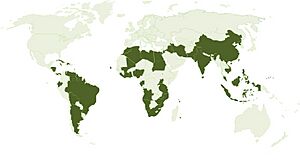South Centre (organization) facts for kids
| Formation | 31 July 1995 |
|---|---|
| Type | Intergovernmental organisation |
| Legal status | Treaty |
| Purpose | Economic development for the South |
| Headquarters | Geneva, Switzerland |
|
Region served
|
Global South |
|
Membership
|
53 states |
|
Official language
|
Arabic, Chinese, English, French, Portuguese, Spanish |
|
Executive Director
|
Carlos M. Correa |
|
Parent organisation
|
South Commission |
| Affiliations | United Nations |
| Website | southcentre.int |
The South Centre is an organization where many developing nations (countries that are still growing their economies) work together. It was officially started by an agreement between governments on July 31, 1995. Its main office is in Geneva, Switzerland.
The South Centre acts like an independent group that studies important global issues and suggests solutions. It also has a special "observer status" at the United Nations and other international groups. This means it can attend meetings and share ideas, helping to represent the interests of developing countries.
How the South Centre Started
The South Centre was created in 1995 because countries in the "Global South" wanted to work more closely together. The Global South refers to countries in Africa, Latin America, and most of Asia.
Before the South Centre, there was a group called the South Commission. This commission realized that countries in the South needed to cooperate more on a global scale. In their report, The Challenge to the South, they highlighted how important it was for these countries to unite and support each other.
Speaking Up for Developing Nations
The South Centre has a special "observer status" at many important international meetings. This means they can attend discussions, share their views, and offer advice, even though they don't have a vote. This helps them speak up for the needs and interests of developing countries around the world.
They have observer status at major organizations like the United Nations General Assembly, the World Intellectual Property Organization, and the World Trade Organization. This allows them to influence decisions on topics like trade, climate change, and health.
Countries That Are Members
The South Centre has a group called the Council of Representatives. This council is made up of important people from each member country. They meet every year to check on the South Centre's work and give guidance.
Each country that joins the South Centre chooses a high-level person to represent them on this council. This person is usually someone known for helping the development of the South and promoting cooperation between these countries. The council also chooses a board and elects the chairperson of the South Centre.
As of 2017, 54 countries have officially joined the South Centre. Here is a list of these member states:
 Algeria
Algeria Angola
Angola Argentina
Argentina Barbados
Barbados Benin
Benin Bolivia
Bolivia Brazil
Brazil Burundi
Burundi Cabo Verde
Cabo Verde Cambodia
Cambodia China
China Côte d'Ivoire
Côte d'Ivoire Cuba
Cuba North Korea
North Korea Dominican Republic
Dominican Republic Ecuador
Ecuador Egypt
Egypt Gabon
Gabon Ghana
Ghana Guyana
Guyana Honduras
Honduras India
India Indonesia
Indonesia Iran
Iran Iraq
Iraq Jamaica
Jamaica Jordan
Jordan Liberia
Liberia Libya
Libya Malawi
Malawi Malaysia
Malaysia Mali
Mali Mauritius
Mauritius Micronesia
Micronesia Morocco
Morocco Mozambique
Mozambique Namibia
Namibia Nicaragua
Nicaragua Nigeria
Nigeria Pakistan
Pakistan Palestine
Palestine Panama
Panama Philippines
Philippines Seychelles
Seychelles Sierra Leone
Sierra Leone South Africa
South Africa Sri Lanka
Sri Lanka Sudan
Sudan Suriname
Suriname Tanzania
Tanzania Uganda
Uganda Venezuela
Venezuela Vietnam
Vietnam Zimbabwe
Zimbabwe
Some countries were members in the past but are no longer part of the South Centre:
 Colombia (was a member from 1997 to 2007)
Colombia (was a member from 1997 to 2007) Serbia and Montenegro (was a member from 1996)
Serbia and Montenegro (was a member from 1996)


